This is a Yashica 35 rangefinder camera made by Yashica Co. Ltd between the years of 1958 – 1959. It was Yashica’s first fixed lens rangefinder, and the first new model released after Yashima’s merger with Nicca which formed the new Yashica company in May 1958. It is a fixed lens 35mm rangefinder with a bright, non parallax corrected viewfinder. My example has a 4.5cm f/2.8 Yashinon lens, but others were available with an f/1.9 Yashinon. It is a well built mechanical camera made almost entirely of metal and glass.
 Film Type: 135 (35mm)
Film Type: 135 (35mm)
Lens: 4.5cm f/2.8 Yashinon coated 5-elements
Focus: 1 meter to Infinity
Viewfinder: Coincident Image Coupled Rangefinder with 45mm Projected Frame Lines
Shutter: Copal MXV Leaf
Speeds: B, 1 – 1/500 sec
Exposure Meter: none
Battery: none
Flash Mount: Coldshoe and PC X-sync port
Weight: 702 grams
Manual (similar model): http://www.cameramanuals.org/yashica_pdf/yashica_35_yk.pdf
How these ratings work |
The Yashica 35 was Yashica’s very first fixed lens 35mm rangefinder and was the first in a huge lineup of 35mm rangefinder cameras that would last well into the 1970s with the Yashica Electro. It is very well built and has features that are consistent with quality rangefinders from the late 1950s. Despite being completely mechanical and meterless, it is not hard to use, and with only a rudimentary understanding of exposure, can be used to take quality pictures with ease. The camera was in production for only 2 years and can be somewhat hard to come by today, but if one ever crosses your path for a reasonable price, it is a camera worth adding to your collection, or better yet, loading in a roll of film and shooting! | ||||||
| Images | Handling | Features | Viewfinder | Feel & Beauty | History | Age | |
| 1 | 1 | 1 | 1 | 2 | 0 | 30% | |
| Bonus | none | ||||||
| Final Score | 7.8 | ||||||
History
The Yashica camera company originally started as two separate Japanese companies both who made cameras along with other products. The first, was Kōgaku Seiki which was formed in 1940 by several ex employees of Canon. In 1942, they released their first model, the Nippon, which was a Japanese clone of the popular German Leica camera.
Meanwhile in 1949, the Yashima Seiki Company was founded who primarily made electronic parts for clocks. They eventually moved onto camera parts and released their first camera, the Pigeonflex in 1953 which was based off another German camera, the Rolleicord.
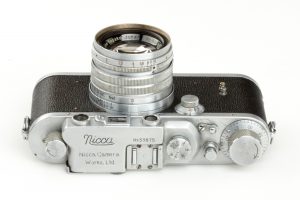
In 1948, Kōgaku Seiki Company changed its name to Nippon Camera Works, and a year later changed it again to Nicca Camera Works. The company continued to build clones of Leica cameras. Although these early Nicca cameras were not very successful, they remain valuable collector’s items today.
Although both the Yashima and Nicca companies made good cameras, after Japan’s defeat in World War II, not many people outside of Japan were interested in a Japanese copies of German designed cameras. Despite their success at making good cameras, both companies struggled to sell their models in large volumes.
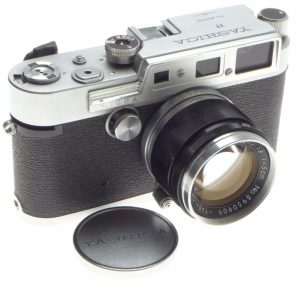
In May 1958, Yashima would acquire Nicca Camera Works. They combined the resources of both companies and changed their name to Yashica Co., Ltd. which itself was a combination of both company’s names. Yashica would continue to release new TLR models, but would release two previous Nicca models under the Yashica nameplate, called the Yashica YE and YF which used LTM screw mount lenses. Both of these models strongly resembled the Leica IIIf and would be the last Yashica models with an interchangeable lens mount.
In 1958, Yashica would release it’s first fixed lens rangefinder, the Yashica 35. Although an all new design, this camera had design elements that loosely resembled Nikon’s S-series rangefinder of the same era. With the release of the Yashica 35, the company would begin a decade long blitzkrieg of new TLR, SLR, and rangefinder models. Yashica would release several lines of cameras with nearly constant revisions and improvements. I was unable to find any marketing or advertising material for this camera, but I would guess the selling price was somewhere in the $50 – $70 range.
Finding any specifics about the Yashica 35 was incredibly difficult. In fact, I’d say this was one of the most elusive cameras I’ve ever written info on. For one, it seems that it was only made for a very short period of time. Some sources say from 1958 – 1959, and others til 1960. But second, Yashica would later release an incredibly popular line of cameras known as the Yashica Electro 35 and when searching for any information for a Yashica 35, you only seem to find information about the Electro series. The only good source of information for this model that I’ve been able to find is Joe Marcel Wolff’s Yashica-Guy website where he devotes a couple of paragraphs to this model.
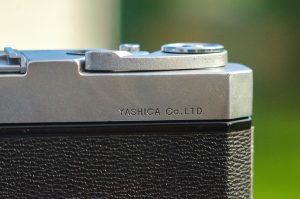
From what I’ve been able to piece together, I believe the Yashica 35 was in development before the merger between Yashima and Nicca, but was released right around the same time as the merger. According to the Yashica-Guy article, variants exist of this camera that credit it being made by both Yashima and Yashica. A recurring statement online is that the Yashica 35 was the very first camera released under the newly merged company, but the presence of some models with “Yashima” on the back contradicts this claim. I do not know if the Yashima versions were released prior to the merger in May 1958, or if the first few off the production line were made with the original name before they had a chance to change it. Since there is so little info about this model, we’ll likely never know.
Edit (7/19/19): Since writing this review, I had the opportunity to interview Paul Sokk from yashicatlr.com. Paul is very knowledgeable about the history of Yashica and Yashima and we discuss the Yashica 35 towards the end of that review, helping to shine a little more light on transition between the two names. If you’d like to know more, I recommend reading that interview.
In addition to the Yashima/Yashica variants, there also exists versions of this camera with either an f/1.9 Yashinon or an f/2.8 Yashinon lens. I have never found any indication of how many of these cameras were made, or if there is any way to date the serial numbers.
I attempted to research other Yashica models to see if there was any way to decode a year of manufacture from the serial number, and other than some Yashica TLRs, it does not seem like Yashica made much of an effort to keep good records of how many were made and in what years. I have previously tried unsuccessfully at getting information about the Yashica Electro’s serial numbers, but there simply doesn’t appear to be any record of that. In any case, the Yashica 35 was a short lived model that gave away to multiple lines of new Yashica rangefinders over the next decade.
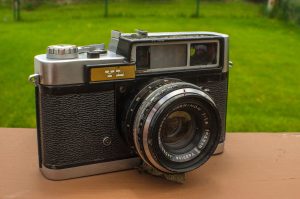
In 1959, Yashica would release two new models, the YK and YL, neither of which were produced for very long either. The YK was a simplified version of the original 35, but with a lower spec shutter with a top speed of 1/300 seconds instead of 1/500. The Yashinon f/1.9 lens was not available on the YK. The YL however seemed to be an entirely new design. Perhaps designed in cooperation with Nicca, the YL had a completely unique stepped top plate with a rewind crank relocated to the bottom of the camera. The YL was offered with both the f/2.8 and f/1.9 lenses like the original 35, but also added parallax correction and an improved rangefinder.
Today, almost all Yashica rangefinders are in demand by collectors, some more than others. The most popular models are the Lynx models with the f/1.4 lenses and the Yashica Electros, both of which are sought after for their excellent optics and ease of use. It is generally accepted that all Yashinon lenses were quite good, which helps improve the reputation of Yashica made cameras. The Yashica 35 specifically would probably be in higher demand if there were more out there. Since they don’t come up for sale often, people don’t always keep an eye out for one, but when found in good condition, especially with the f/1.9 lens, they can fetch a pretty decent price.
My Thoughts
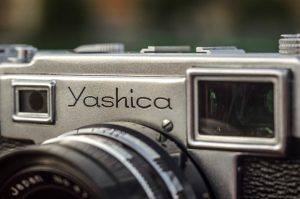
I really like Yashica rangefinders. It started with my early admiration of the Electro and continued with the Minister-D and the Lynx series. Yashica was one of the few early Japanese camera makers to survive the 50s and keep making quality products throughout the 60s and into the 70s. During that time, they released an incredible number of rangefinder and SLR cameras, some of which were nearly identical to other models in their lineup. I cannot imagine what it must have been like to be a Yashica dealer in the mid 60s when the company was releasing multiple new models every year.
I’ve reviewed a variety of different Yashica cameras on this site and in the History section, I almost always cover the period of time when Yashima Optical acquired Nicca Camera Works and became Yashica. Nicca had a line of well built and expensive Leica inspired interchangeable lens mount rangefinders, but it must have been clear to the leaders at Yashica that the market for high end rangefinders to compete with Canon, Nikon, and the Germans was difficult, so they started work on a lower end model that lacked an interchangeable lens.
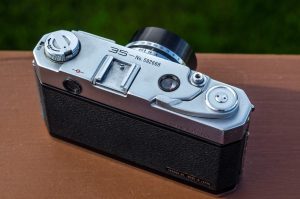
I had seen a couple of these Yashica 35s on review sites, but never could find one in good enough condition to pick up. Making acquiring one difficult is that the name “Yashica 35” returns a ton of results when searching Google or eBay for them as many Yashica cameras have the number 35 in the model number, or the characters “35mm” in the title. In fact, as I write this article, an eBay search for “Yashica 35” in the Cameras & Photo category returns 1217 listings, yet only about 5 of those are actual Yashica 35s.
Using some of eBay’s more advanced search options, I created a custom search in both the Vintage Cameras category and Film Cameras category that you can use which narrow it down to about 100. It is important when searching for things in a search engine not to get too specific, as you might filter out what you’re actually looking for. For example, filtering out “35mm” from your search would remove an auction called “Yashica 35 35mm Camera” from your search results.
Once I managed to locate a nice looking Yashica 35 in my “sub $20” price range, I eagerly awaited for it to arrive and when it did, there was some good and bad. I’ll start with the good.
It looked nice…
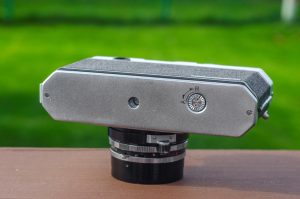
That’s about it, because there were many issues. The shutter was frozen, the focus was extremely stiff, and the viewfinder was cloudy and extremely difficult to see the rangefinder patch. I began a several month long process into repairing this camera. Normally it doesn’t take me as long as it did with this camera to go through it, but I sorta….you know….misplaced part of the lens halfway through my repair. Thankfully, I found it and was able to get the shutter cleaned up and working, but the list of problems had only begun.
I’ll save you a long diatribe of all the hoops I had to jump through to get this camera working, but I’ll just say that I think the Yashica 35 was a well built camera, but being an early rangefinder, it had a design that wasn’t quite what I was used to and I had some challenges that I hadn’t encountered with other cameras. The viewfinder was easy to get access to, but unlike other 50s and 60s rangefinders, it doesn’t have a traditional beamsplitter, it has a glass prism made of two triangular pieces of glass, with a semi-reflecting coating sandwiched between the two and glued together.
I don’t see there being a lot of demand for an in depth tutorial on how to disassemble this camera for cleaning, so I’ll just include a gallery of some pics I took while I had the camera apart. Each image in the galley below has some notes on what I was doing at the time for anyone interested.
With the camera back together, the shutter working properly at all speeds, the focus ring lubed, and the viewfinder mostly clean, I was ready to shoot some film in the camera. The most immediate thing you’ll notice when handling the Yashica 35 is how solid it feels. An odd thing while handling the 35 was that I was convinced it weighed more than a Yashica Electro, but then I put it on my kitchen scale and found that not to be true. Without film loaded, the Yashica 35 weighs 702 grams and a Yashica Electro 35 GSN without battery weighs 715 grams. Made in 1958, the Yashica 35 predates the prevalence of plastic in later cameras so I was convinced it was heavier until I saw the two on the scale. Perhaps it’s the smaller size of the 35 that just gives it the illusion of being heavier, but whatever the reason, it is still a solid camera.
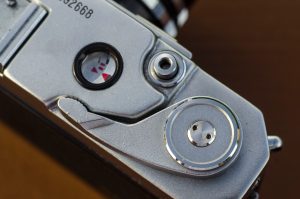
The viewfinder in the Yashica 35 is bright and modern. It has non parallax corrected bright lines to indicate the 45mm frame and a small rangefinder patch in the center. The rangefinder was a bit difficult to see on this camera, but no worse than any other Yashica I’ve used. While shooting with the Yashica 35, I found it to be a comfortable and intuitive camera to use. I really liked the wind lever on the camera as it tucks nicely into the top plate of the camera. Considering it’s age, there was little in the way of quirks or special care to get good images.

An ever so slight nitpick I found while shooting was the self timer’s location on the bottom of the lens was in a position that was easily bumped by my hand while focusing. There were a couple of times during my first roll where I accidentally triggered the self timer which caused a 1-2 second delay in shooting. I would imagine that this something you’d get used to with repeated use, but considering this was my first time using this camera, it did trip me up a couple of times.
One other thing of note is that unlike most Japanese rangefinders I’ve encountered, the focus scale on this camera is metric only, so if you plan on using the depth of field marks, you’ll have to do it in meters, rather than feet. Metric only scales are common on early German cameras, but I don’t think I have seen another Japanese camera with metric only.
Otherwise, my experience was very pleasurable. In some ways, it seemed to me that Yashica really had their act together in the 1950s. Both their Nicca LTM rangefinders and their Yashica TLRs were excellent examples of each style of camera that compared very favorably to the German models they were modeled after. The Yashica 35 is a very solid and nicely built camera. While I won’t suggest that subsequent models like the Lynx, Minister, or Electro lines were cheap, I feel as though the Yashica 35 is just a notch higher in quality. I have to wonder if the bean-counters at Yashica were already feeling the pressure of the over saturated Japanese camera market by the late 1950s. I can only wonder how the company might have fared if they continued making German quality interchangeable lens rangefinders into the 60s or 70s.
My Results
At the same time I was ready to shoot the Yashica 35, I also wanted to take out a Brumberger 35, which is a rebadged Neoca 2S rangefinder. The Brumberger was in nice physical shape, but had an extremely dirty viewfinder and a rangefinder patch that was almost invisible. Both the Yashica and Brumberger were Japanese built rangefinders from the mid to late 50s with similar specs. It was late winter, and my inspiration was low, so in an effort to not drag out two complete rolls of film in each camera, I made the decision to split a 36 exposure roll of Kodak TMax 400 between both cameras so that I could shoot 18 exposures between the two and see what each could do. That way, if one or both of them failed, I would only ruin one roll of film, and not two. Confirming my choice for black and white film was that I shot both cameras in late winter when there were still no leaves on the trees and the weather was regularly gray and overcast.
I didn’t know what to expect from the Yashica 35. On one hand, I regularly have gotten excellent results from other Yashica rangefinders like the Electro, Minister D, and Yashica TLRs with their excellent Yashinon lenses, but on the other, this is the oldest Yashica rangefinder I’ve ever used and the one that had the most condition issues when I acquired it.
Looking through these images, I am generally pleased with their quality. I don’t get that sense of razor sharpness like I have had with other Yashica cameras, but that could be a result of the type of film I used, there could be something misaligned in the lens elements, or it could be that these earlier 35mm Yashinon lenses just simply weren’t as good as later versions.
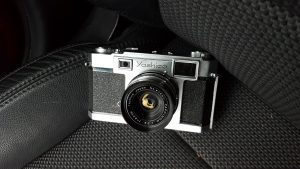
Whichever the case, these shots are far from bad. I struggled to get perfect focus on a couple of images, but most were OK which tells me that despite being very small, the rangefinder was working correctly. Center sharpness is very good, and I saw only minor amounts of softness around the edges. Since I shot many of these images on hazy or overcast days, most were at f/5.6 and wider. I wonder what this camera would be capable of with better film on a bright and sunny day at f/8 or f/11 where most lenses are at their sharpest. I detect an ever so slight amount of overexposure on a few frames, but that could simply be my own choices for exposure, rather than the possibility of the shutter being slow.
It was good that I went into this camera with modest expectations because had I hoped for stellar results, I might have been disappointed. It’s important to remember that the target customer who might have bought a Yashica 35 in 1958 would not have expected top of the line optics. The camera is all metal and feels solid in your hands. By 1950s standards, the viewfinder is reasonably bright and easy enough to use, and other than the location of the self timer which I accidentally hit a couple of times, I found the ergonomics of the camera to be good. Plus, I also have to consider that this camera is nearly 60 years old, and who knows how many times it’s been taken apart or bumped causing minor performance aberrations.
I think the Yashica 35 is a handsome camera with a classic design that looks great on a shelf, it’s easy to use, and although I didn’t get any amazing shots out of it, it’s far from a disappointment. These cameras aren’t exactly common, so I doubt anyone reading this article is going to run out and start buying up the world’s supply of them, but my advice is that if you ever come across one for a decent price, it is absolutely worth a try.
Related Posts You Might Enjoy
External Links
http://camera-wiki.org/wiki/Yashica_35
http://www.yashica-guy.com/document/variations.html
https://www.photo.net/discuss/threads/the-yashica-35-rangefinder-1957.477365/
http://www.rangefinderforum.com/forums/showthread.php?t=114029

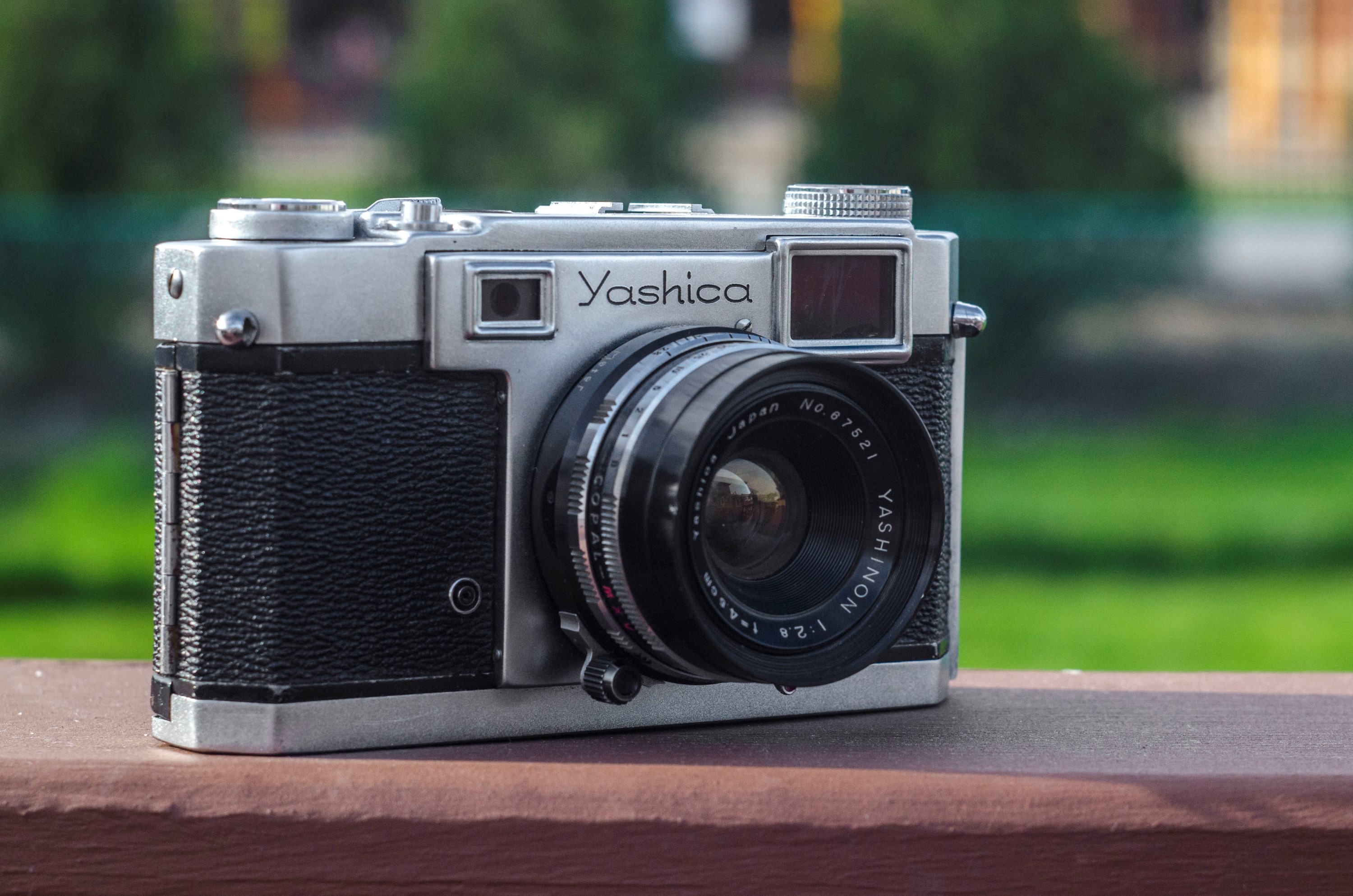




















As usual, every bit the excellent article, and certainly one that echoes a thought in my mind that the build quality of the Japanese rangefinder hit its pinnacle in the late 1950’s, even as features were added and specs improved through the 1960’s. One only wonders what sort of products we might have seen had the build quality held steady throughout – imagine a Lynx with a sparkly 1950’s style body design! Still, such a thing may well not have been sustainable as the market began shrinking!
Great piece, very impressed.
Excellent article Mike thanks so much as I have been looking far and wide for info on this little fella. Just as a point of interest, my copy has the 2.8 45mm lens and the focusing scale is in feet only, no sign of metric. Perhaps for reasons best known to themselves, they decided to keep metric on the 1.9 lens and imperial on the 2.8?
Thanks for the feedback Paul. It is peculiar how randomly Yashica seemed to change things back then, feet, metric, 8 digit serial numbers, 6, etc. Its almost like they had a rotating door of people who would change direction quickly. In any case, the Yashica 35 is a great camera, and although mine has some mechanical flaws, I was still impressed with the images I got from it.
Great article. I have the 1.9 version which seems to have a focusing problem. When trying to focus, the images won’t fully align in the viewfinder so that they completely overlap. Is there any way to recalibrate the focusing to remedy this problem?
Thanks for your excellent article Mike. I’ve just bought a Yashica 35 from my local charity shop. Like Paul, my camera had the Yashinon 4.5cm f2.8 lens with a focus scale in feet rather than metres. It also has Yashima Opt. Ind. Co., LTD engraved on the back. Camera model number is 588****. The camera seems to be working okay but the film winding lever has clearly had some repair work done. There is a small coin on top acting as a washer for a screw!! I’m looking forward to cleaning the camera and using it.
Mike, how easy is it to remove the top plate of the Yashica 35? I can remove the rewind knob, the screw in the cold shoe and the small screws on each side. What am I missing? The top plate won’t budge. It appears that the camera has been dropped a few times, distorting the top plate on the righthand side of the camera so that it interferes with the movement of the film advance lever. I’d like to be able to remove the top plate to try and make the hole for the film advance lever circular once more. Any tips would be gratefully received. There’s not much information on this camera on the internet!
Ive got a yashica 35 serial no-5102150 with a 1:2.8 f=4.5cm lense in fairly great condition with its original black 2 piece leather case n all buttons work smoothly n on the back it says yashica co.ltd im in Australia if anyones keen to offer me a decent price my email is [email protected] throw me an email n ill send you some pics of it if you are interested n thanks for the info on it cause i could only find one on ebay for about 135 dollars n its case was in poor condition i dont know how good the camera was but it didnt look damaged …. anyway thanks for readin my reply
Hi Mike, Very well presented and an excellent review. I can answer some of your questions and maybe solve a few of the mysteries surrounding Yashima-Yashica and this camera.
Yes this was Yashima-Yashica’s first 35mm camera. Up until this point in time they were known as a TLR maker and 8mm camera maker. Yashima is Yashica. Yashima Optical became Yashica separate from Nicca. Yashima had called their cameras Yashica since 1954. Nicca was making high quality 35mm rangefinder cameras on their own. There’s no evidence that Yashica and Nicca shared anything prior to Yashica acquiring them in 1958. Nicca ceased to exist at that point as they were absorbed into the bigger corporation.
Serial numbers – the 35 that you have presented here (No. 592668) was made in September of 1960 and was the 2,668th made that month. Yashica was all over the map with how they were numbering their cameras but in your case the “5” is the indicator for the year expressed as the Showa year. Showa “55” is 1960 (always add 25 to the Showa date). The “9” is for September and they numbered the cameras in sequence for that month. They didn’t do this consistently though – my camera is serial number (6121150) which decodes to December 1961 and is the 1,150th made that month. There are some of these models that use the straight 2 digit Western date. I know, confusing. Other Yashica models are much more straightforward – the Pentamatic uses the Western date for the year and then the month and then the sequence number for the year.
Dear Chris and Carol , can you explane the number of my 35 ;? it is : 3931317 .
Hi Paulus, I don’t know if Chris has seen your post. He and I have worked on the serial numbers together. I can tell you that the 39 stands for 1959 and the following 3 is March. If I said that the 3 of 39 is from Showa 34 and the 9 from 1959, you’d be entitled to say “pull the other one”. However, I have looked at literally thousands of Yashica cameras and that’s how they seem to work for this period. Basically the system is a one or two digit year, one or two digit month and then a four digit sequence number counting up from 0001 at the start of the month. The year bit is what Yashica got tricky with trying to disguise, e.g. the early part of 1959 was “39”, in the middle of March it changed to just “4”, still from Showa 34. Late 1959 was different again but I don’t want to complicate things.
A great article thank you, which I turned to having just purchased a f1.9 version with (and I didn’t know this until it arrived) the Yashima back plate. I was so pleased with the Yashima thing I pushed the boat out and bought an original lens hood (which must be quite rare I should think)
A few issues though, sticky slow speeds and a piece of something (not fungus, but threads are growing around it) in the rear lens element. Have you tried taking the lens fully apart on one of these, I think it is in the lens assembly behind the shutter.
Also the viewfinder glass is loose inside the top plate, but that should be easy to fix.
Thanks Mike you have been very helpful. My Dad gave me a suitcase full of old cameras that he has collected over the years I found the YL serial Number starting 410…. It looks in good condition and still in its case. I might take you advice and put a role of film in it. Dad also had a Ross Ensign Selfix 8-20 Special so I might have to recapture my passion. Thanks very much
Mike, I am the happy owner of a 35 as you discribed , it seems im realy mint condition I have also the original cardboard box .
Bud my camera has one issue: the rewind knob is verry lose if I hold the camera upside down it comes out , not completely ofcourse ( it is blocked inside ) .
Is there somethign missing inside ?
Its really hard to tell. If the rewind knob doesn’t stay tight against the body when turning the camera upside down, there’s likely a pin missing that is there to hold the shaft in place. Most 35mm cameras with a rewind knob have some way of keeping the shaft from coming loose, so someone likely took it apart and didn’t put it back together correctly. Sadly, there’s really no way to know without taking it apart yourself and salvaging parts from another Yashica 35. You said your example is in excellent condition, so it might be worth it to find a parts donor.
Mike , i have taking it apart and it doesn’t look like someting is missing , there is the knob with the lever, held in place by a smal screw , this knob can be removed from the shaft , by turning it caunter clockwise whilst holding the shaft still .
The shaft can be removed on the inside of the camera , this shaft has a bushing .
What i have done now is : i aplied some verry stif grease on the outside of the bushing .
This semes to work .
Is it possible to find explosive drawings of this camera ?
That would help .
P.
I stumbled across one of these with 45mm/2.8 a year or two ago. I must say it is a deligthful little camera. Great review! (As always).
Thanks for the compliments, Sven! The f/2.8 is still a quality lens, although I would be curious to shoot one with the f/1.9!
Mike , a few years ago I have bought one becouse it was a range finder without knowing wat kind of rangefinder it was .
It is in mint condition with lenscap and original box , I love it ( as i do Yashica’s in general)
Nice to know the history.
Glad to hear that you found a nice specimen of this camera. Mine’s in not so good of shape, but as you can see, still made some wonderful photographs!
Since we are talking serial numbers. My 35-F has number 6110969 and the Yashinon 4,5cm/2.8 lens has number 223481. I guess that could mean it was made in November 1961 and was the 969th camera made that month. Maybe. Did I read the earlier posts right?
You read the posts right but my mate Chris slipped up! We’ve worked on Yashica serial numbers together so we both agree how they operate. His camera is from Dec 1960, not 1961 (he knows that). Likewise, your camera is from Nov 1960. The 969th made for the month is correct. There is more on Yashica 35 serial numbers here http://www.yashicatlr.com/Yashica35.html#numbers including why I think there is no “35-F” model.
great mate
Thank you for the informative review. I love Yashicas, having bought my first Lynx 5000 in 1969. Since then another two 5000 models. two 1000 models and a pristine Lynx 14.
Then I discovered the “35” from 1958 and was immediately impressed with its quality. I acquired three of the 2.8 lens versions and one 1.9 example. Just sold one of the 2.8 examples, all in excellent condition. The Lynx 1.8 lens had impressed me greatly, and I expected nothing less from the 2.8 Yashinon. It was excellent and if anything exposed the 400ASA grain as the limiting resolution.
There is something about the 35 that gives me great satisfaction. Included is its quality, its mechanical simplicity and the lens. The 2.8 has fewer bits of glass which means less reflection area. Bigger apertures need more glass, so I am happy to stay with “less is more’ in this area. The Lynx 5000 certainly has a wonderful lens, but it just doesn’t project that solid quality feel from the early era.
Arnold, thanks for the compliments. I can not only echo your praise for the Yashica 35, but having experience opening one up, I can confirm the camera is built with a level of quality higher than later Yashica’s. The most obvious difference is the Yashica 35 is the only Yashica rangefinder with a prism viewfinder like Nikon and Zeiss used. All later Yashicas use optical glass and a beamsplitter. The beamsplitter method is less expensive, but has the side effect of getting dirty easy and de silvering. There were other quality improvements in the 35 as well such as a metal plate on top of the viewfinder to keep stay light out. Later Yashicas used a piece of black paper to do the trick. It’s a fantastic camera that I only wish I had a better example of.
Mike, some information. After you mentioned the model with “Yashima Opt. IND. Co., LTD” on the back I checked my collection.
One of my “35”s has this engraved on the back below the rewind lever. This model is slightly different from the later 35 in the following way:
1)The red cocked ‘loaded’ indicator is not in the counter window, but has its own small window next to it.
2) Additionally, when cocking, the counter doesn’t advance until the shutter button is pressed and released
3) The rewind release underneath is a push button, unlike the rotation selection on the later model.
4) My early model serial No. starts with 3340 and the last three are less than 200
Hope this will add to your excellent summation as it is obvious that there is little other information on this out there